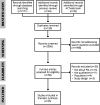Behaviours that prompt primary school teachers to adopt and implement physically active learning: a meta synthesis of qualitative evidence
- PMID: 34801039
- PMCID: PMC8605507
- DOI: 10.1186/s12966-021-01221-9
Behaviours that prompt primary school teachers to adopt and implement physically active learning: a meta synthesis of qualitative evidence
Abstract
Background: Physically active learning (PAL) - integration of movement within delivery of academic content - is a core component of many whole-of-school physical activity approaches. Yet, PAL intervention methods and strategies vary and frequently are not sustained beyond formal programmes. To improve PAL training, a more comprehensive understanding of the behavioural and psychological processes that influence teachers' adoption and implementation of PAL is required. To address this, we conducted a meta-synthesis to synthesise key stakeholders' knowledge of facilitators and barriers to teachers' implementing PAL in schools to improve teacher-focussed PAL interventions in primary (elementary) schools.
Methodology: We conducted a meta-synthesis using a five-stage thematic synthesis approach to; develop a research purpose and aim, identify relevant articles, appraise studies for quality, develop descriptive themes and interpret and synthesise the literature. In the final stage, 14 domains from the Theoretical Domain Framework (TDF) were then aligned to the final analytical themes and subthemes.
Results: We identified seven themes and 31 sub-themes from 25 eligible papers. Four themes summarised teacher-level factors: PAL benefits, teachers' beliefs about own capabilities, PAL teacher training, PAL delivery. One theme encompassed teacher and school-level factors: resources. Two themes reflected school and external factors that influence teachers' PAL behaviour: whole-school approach, external factors. Ten (of 14) TDF domains aligned with main themes and sub-themes: Knowledge, Skills, Social/Professional Role and Identity, Beliefs about Capabilities, Beliefs about Consequences, Reinforcement, Goals, Environmental Context and Resources, Social influences and Emotion.
Conclusions: Our synthesis illustrates the inherent complexity required to change and sustain teachers' PAL behaviours. Initially, teachers must receive the training, resources and support to develop the capability to implement and adapt PAL. The PAL training programme should progress as teachers' build their experience and capability; content should be 'refreshed' and become more challenging over time. Subsequently, it is imperative to engage all levels of the school community for PAL to be fully integrated into a broader school system. Adequate resources, strong leadership and governance, an engaged activated community and political will are necessary to achieve this, and may not currently exist in most schools.
Keywords: Behaviour; Implementation; Physical activity; Physically active learning; School; Systematic review; Teachers; Thematic synthesis; Theoretical domains framework; meta synthesis.
© 2021. The Author(s).
Conflict of interest statement
The authors declare that they have no competing interests.
Figures
Similar articles
-
Barriers and facilitators to the implementation of a school-based physical activity policy in Canada: application of the theoretical domains framework.BMC Public Health. 2017 Oct 23;17(1):835. doi: 10.1186/s12889-017-4846-y. BMC Public Health. 2017. PMID: 29061140 Free PMC article.
-
Implementing physically active learning: Future directions for research, policy, and practice.J Sport Health Sci. 2020 Jan;9(1):41-49. doi: 10.1016/j.jshs.2019.05.007. Epub 2019 May 24. J Sport Health Sci. 2020. PMID: 31921479 Free PMC article.
-
Comprehensive school health: teachers' perceptions and implementation of classroom physical activity breaks in US schools.Health Promot Int. 2022 Oct 1;37(5):daac100. doi: 10.1093/heapro/daac100. Health Promot Int. 2022. PMID: 36166261
-
Effect of capacity building interventions on classroom teacher and early childhood educator perceived capabilities, knowledge, and attitudes relating to physical activity and fundamental movement skills: a systematic review and meta-analysis.BMC Public Health. 2024 May 27;24(1):1409. doi: 10.1186/s12889-024-18907-x. BMC Public Health. 2024. PMID: 38802762 Free PMC article.
-
Barriers and facilitators to the implementation of physical activity policies in schools: A systematic review.Prev Med. 2018 Feb;107:45-53. doi: 10.1016/j.ypmed.2017.11.012. Epub 2017 Nov 16. Prev Med. 2018. PMID: 29155228
Cited by
-
Primary School Pupils' Perceptions and Experiences of Wearable Technologies.J Sch Health. 2024 Dec;94(12):1119-1128. doi: 10.1111/josh.13509. Epub 2024 Nov 6. J Sch Health. 2024. PMID: 39502018 Free PMC article.
-
Promoting physical activity and academic achievement through physically active learning: Qualitative perspectives of co-design and implementation processes.PLoS One. 2023 Nov 22;18(11):e0294422. doi: 10.1371/journal.pone.0294422. eCollection 2023. PLoS One. 2023. PMID: 37992080 Free PMC article.
-
Teacher acceptability of physically active learning in UK secondary schools - a mixed methods study.PLoS One. 2025 Aug 14;20(8):e0328376. doi: 10.1371/journal.pone.0328376. eCollection 2025. PLoS One. 2025. PMID: 40811522 Free PMC article.
-
Reframing physically active learning as movement-centred pedagogy: a European priority action framework.Int J Behav Nutr Phys Act. 2023 Aug 25;20(1):101. doi: 10.1186/s12966-023-01503-4. Int J Behav Nutr Phys Act. 2023. PMID: 37626371 Free PMC article.
-
Mini review: physically active schools as an arena for promoting health and cognition at the same time.Front Sports Act Living. 2025 May 2;7:1532809. doi: 10.3389/fspor.2025.1532809. eCollection 2025. Front Sports Act Living. 2025. PMID: 40386471 Free PMC article. Review.
References
-
- International Society of Physical Activity and Health. ISPAH’s Eight Investments That Work for Physical Activity [Internet]. International Society for Physical Activity and Health; 2020 Nov. Available from: https://www.ispah.org/wp-content/uploads/2020/11/English-Eight-Investmen...
-
- World Health Organisation Global Action Plan on Physical Activity 2018-2030: More active people for a healthier world [internet]. World Health Organisation; 2018. Available from: https://apps.who.int/iris/bitstream/handle/10665/272722/9789241514187-en...
-
- Department of Health and Social Care. Childhood obesity: a plan for action, chapter-2 [Internet]. HM Government; 2018. Report No.: 2. Available from: https://assets.publishing.service.gov.uk/government/uploads/system/uploa...
-
- McMullen J, Ní Chróinín D, Tammelin T, Pogorzelska M, van der Mars H. International approaches to whole-of-school physical activity promotion. Quest. 2015;67:384–399. Available from: 10.1080/00336297.2015.1082920.
-
- Norwegian Ministry of Health and Care services. The Action Plan on Physical Activity 2005–2009. Working together for physical activity [Internet]. Norwegian Ministry of Health and Care services; 2005. Available from: https://www.regjeringen.no/globalassets/upload/kilde/hod/red/2006/0002/d...
Publication types
MeSH terms
LinkOut - more resources
Full Text Sources



